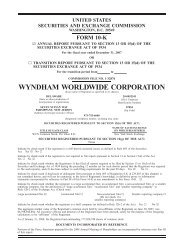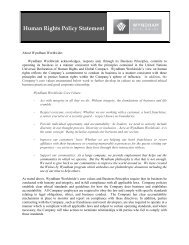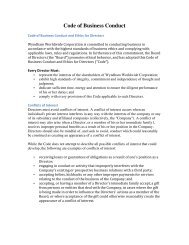WYNDHAM WORLDWIDE CORPORATION
WYNDHAM WORLDWIDE CORPORATION
WYNDHAM WORLDWIDE CORPORATION
Create successful ePaper yourself
Turn your PDF publications into a flip-book with our unique Google optimized e-Paper software.
performance for a five-year period. The most significant assumptions used in the discounted cash flow methodology<br />
are the discount rate, the terminal value and expected future revenues, gross margins and operating margins, which<br />
vary among reporting units.<br />
We use a market multiple methodology to estimate the terminal value of each reporting unit by comparing such<br />
reporting unit to other publicly traded companies that are similar from an operational and economic standpoint. The<br />
market multiple methodology compares each reporting unit to the comparable companies on the basis of risk<br />
characteristics in order to determine the risk profile relative to the comparable companies as a group. This analysis<br />
generally focuses on quantitative considerations, which include financial performance and other quantifiable data,<br />
and qualitative considerations, which include any factors which are expected to impact future financial performance.<br />
The most significant assumption affecting our estimate of the terminal value of each reporting unit is the multiple of<br />
the enterprise value to earnings before interest, tax, depreciation and amortization.<br />
To support our estimate of the individual reporting unit fair values, a comparison is performed between the sum<br />
of the fair values of the reporting units and our market capitalization. We use an average of our market capitalization<br />
over a reasonable period preceding the impairment testing date as being more reflective of our stock price trend than<br />
a single day, point-in-time market price. The difference is an implied control premium, which represents the<br />
acknowledgment that the observed market prices of individual trades of a company’s stock may not be representative<br />
of the fair value of the company as a whole. Estimates of a company’s control premium are highly judgmental and<br />
depend on capital market and macro-economic conditions overall. We evaluate the implied control premium for<br />
reasonableness.<br />
Based on the results of our impairment evaluation performed during the fourth quarter of 2010, we determined<br />
that no impairment charge of goodwill was required as the fair value of goodwill at our lodging and vacation<br />
exchange and rentals reporting units was substantially in excess of the carrying value.<br />
Based on the results of our impairment evaluation performed during the fourth quarter of 2008, we recorded a<br />
non-cash $1,342 million charge for the impairment of goodwill at our vacation ownership reporting unit, where all<br />
of the goodwill previously recorded was determined to be impaired. As of December 31, 2010, 2009 and 2008, our<br />
accumulated goodwill impairment loss was $1,342 million ($1,337 million, net of tax).<br />
The aggregate carrying values of our goodwill and other indefinite-lived intangible assets were $1,481 million<br />
and $731 million, respectively, as of December 31, 2010 and $1,386 million and $660 million, respectively, as of<br />
December 31, 2009. As of December 31, 2010, our goodwill is allocated between our lodging ($300 million) and<br />
vacation exchange and rentals ($1,181 million) reporting units and other indefinite-lived intangible assets are<br />
allocated between our lodging ($625 million) and vacation exchange and rentals ($106 million) reporting units. We<br />
continue to monitor the goodwill recorded at our lodging and vacation exchange and rentals reporting units for<br />
indicators of impairment. If economic conditions were to deteriorate more than expected, or other significant<br />
assumptions such as estimates of terminal value were to change significantly, we may be required to record an<br />
impairment of the goodwill balance at our lodging and vacation and exchange and rentals reporting units.<br />
We also evaluate the recoverability of our other long-lived assets, including property and equipment and<br />
amortizable intangible assets, if circumstances indicate impairment may have occurred, pursuant to guidance for<br />
impairment or disposal of long-lived assets. This analysis is performed by comparing the respective carrying values<br />
of the assets to the current and expected future cash flows, on an undiscounted basis, to be generated from such<br />
assets. Property and equipment is evaluated separately within each segment. If such analysis indicates that the<br />
carrying value of these assets is not recoverable, the carrying value of such assets is reduced to fair value.<br />
Business Combinations. A component of our growth strategy has been to acquire and integrate businesses that<br />
complement our existing operations. We account for business combinations in accordance with the guidance for<br />
business combinations and related literature. Accordingly, we allocate the purchase price of acquired companies to<br />
the tangible and intangible assets acquired and liabilities assumed based upon their estimated fair values at the date<br />
of purchase. The difference between the purchase price and the fair value of the net assets acquired is recorded as<br />
goodwill.<br />
In determining the fair values of assets acquired and liabilities assumed in a business combination, we use<br />
various recognized valuation methods including present value modeling and referenced market values (where<br />
available). Further, we make assumptions within certain valuation techniques including discount rates and timing of<br />
future cash flows. Valuations are performed by management or independent valuation specialists under management’s<br />
supervision, where appropriate. We believe that the estimated fair values assigned to the assets acquired and<br />
liabilities assumed are based on reasonable assumptions that marketplace participants would use. However, such<br />
assumptions are inherently uncertain and actual results could differ from those estimates<br />
Accounting for Restructuring Activities. During 2010, we committed to a strategic realignment initiative<br />
targeted at reducing costs, which will impact operations at one of the call centers in our vacation exchange and<br />
71







